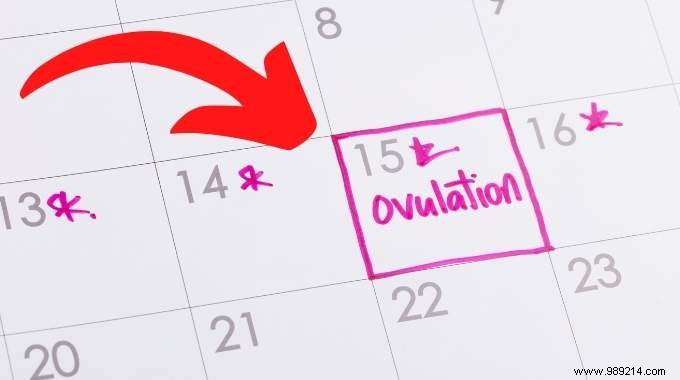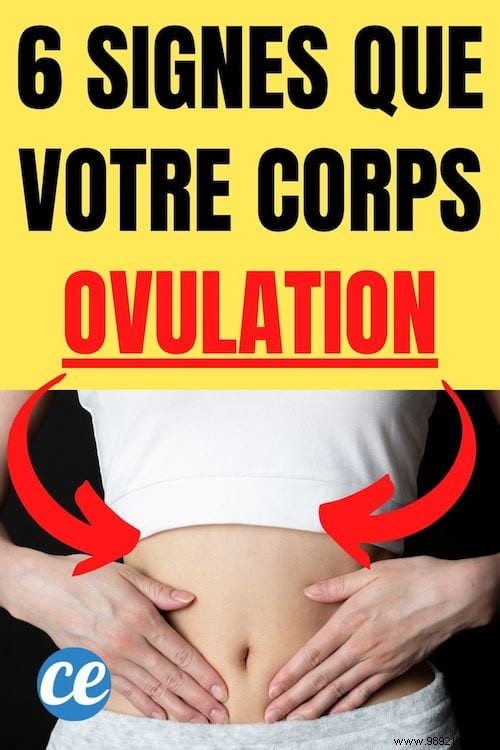
Today we are going to look together at the signs that show that your body is ovulating.
Yes, it is important to know how to spot these natural symptoms .
Because this is the period when a woman is the most fertile .
Do you know what I mean?
It is during ovulation that a woman has the best chance of becoming pregnant!
And what does this actually mean for you?
If you're planning on having a baby, now is the time to do somersaults under the duvet.
But if you don't want to have a baby and you're not using birth control, it's better to abstain!
So now let's see together the 6 grandmother's tricks that show that you are ovulating . Watch:

What the hell is that?
It is a viscous liquid made by the endometrial glands of the cervix.
It constitutes an obstacle for the advance of sperm when they reach the cervix.
But at the time of ovulation, it changes.
And we can deduce that the period of ovulation begins.
At this time, the cervical mucus becomes more abundant, sticky and transparent .
It looks a bit like egg white that can stretch between your fingers.
It is then less thick and stringy than usual.
This method, also called the Billings method, requires you to know your body well.
You have to be able to tell the difference in the texture of the cervical mucus between before and after ovulation.
And be careful, this symptom of ovulation should not be confused with a vaginal infection.
In this case, the mucus is smelly.
White discharge occurs throughout the cycle.
This trick to know whether or not we are in a fertile period requires a little organization.
You should first know that the body temperature increases by a few tenths of a degree for about ten days, every month.
This is what corresponds to the period of ovulation.
Be careful, we are talking about 3 to 4 tenths when you wake up in the morning! It's not much.
But it may be enough to give you a few sweats at night.
But the safest thing is to establish a precise temperature curve throughout the month.
You have to be super rigorous and take your temperature every morning when you wake up at the same time.
This will allow you to easily determine the period during which you are most fertile.
But for this you will need an accurate thermometer.
If the temperature rises under the duvet, it's a positive sign!
It must be said that nature is well done.
Just before the period of ovulation, the body produces hormones that stimulate your libido.
As a result, your sexual desire increases!
Nature has planned everything so that your sexual intercourse increases during your ovulation period...
Just to increase the chances of being pregnant!
Again, it's the hormones' fault !
At the time of ovulation, the breasts may become more tender and heavy.
They are tighter, much like before menstruation.
It is therefore necessary to be attentive to these micro changes.
The best thing is to feel your chest regularly.
This is also the best way to detect a tumor linked to breast cancer.
Pain, abdominal cramps, swollen belly or bloating, tightness in the lower abdomen, small pinching to the right or left...
In some women, ovulation can cause tummy aches .
Fortunately, they are usually much less severe than menstrual pain.
Why does it hurt during ovulation?
It is the expulsion of the egg by the ovary which could be at the origin of these pains.
This is therefore the sign of the beginning of ovulation!
But be careful, if the pain is strong and difficult to bear, you must consult a doctor quickly.
This is perhaps the most difficult natural sign to determine.
Again, you have to know your body well to assess whether you are entering the ovulation phase.
Indeed, during ovulation, the position of the cervix changes.
If ovulation has started, the cervix is higher, straight and open.
To find out if this is the case, you have to squat down and insert two fingers into the vagina.
You can then appreciate the position of the cervix and determine if the ovulation period has started.
I know what you are going to tell me.
This small calculation to be made to determine the period of ovulation is not really a physical sign of ovulation...
And you are absolutely right!
But nothing prevents you from doing it.
And you will see if one of the natural physical signs confirms your calculations!
In this case, there is a good chance that these are the days when you can get pregnant.
How?
A cycle is calculated from the date of her last period
A cycle has 25, 28 or even 35 days.
But in any case, ovulation takes place on the 14th day before the next period.
And the most fertile period for women is 3 to 4 days before ovulation and one day after.
If we do a quick little calculation, we estimate the period of ovulation between the 10th and the 15th day of the cycle.
It is especially during these days that a woman can become pregnant.
Keep in mind that every woman is different.
I insist on this point:each body reacts differently.
It also depends on whether or not you take contraception (the pill, etc.)
The symptoms of ovulation can therefore vary greatly from person to person.
Some women feel them, others don't.
Know that there are ovulation tests that precisely determine the period of ovulation to help you conceive a baby.